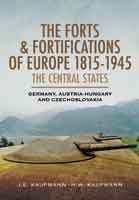Like the title suggests, this wasn’t a book to be read in your lunch break
This was to be no quick read but was specialist reading requiring knowledge of fortifications and the political maelstrom of Central Europe. To make things more interesting it covered the vast timeline of 1815-1945, Europe’s busiest time when it came to shuffling the deck. The book is clearly not aimed at the casual reader nor does it pretend to be but Kaufmann&Kaufmann (sounds like a Bavarian Solicitors firm) lead you headfirst on a wild journey of technical specs, surveyors reports and construction drawings and draughts and don’t apologise once for the bumpy ride nor for the headache you’ll feel afterwards!
Pillboxes are peculiar things when you think about them, they are quite useless compared to today’s high tech warfare armaments.They had a proven life in WW1 to a certain degree but couldn’t withstand a direct hit by the larger calibre guns on the Western front. By the Second World War the pillboxes we see scattered around the English countryside where woefully dated. I look upon them as heroic concrete warriors, standing alone to protect the British people. In reality they were a propaganda stunt; a naive and ridiculous folly that drew money and valuable resources away from other more needy causes in the war effort.
Hitlers Atlantic wall was, again, slightly different. It was…. a wall! A series of deep well sighted gun emplacements and machine gun nests designed to cause maximum havoc in the area where an attack would come from across the sea. Nearly all faced the beaches and the fields just behind and all bar a handful were able to move their guns more than a few degrees either side.But what about the air?What of airborne troops dropped miles behind any beachheads with paratroops attacking these concrete monstrosities from their weak point?It would be like St.George putting his sword in the dragon’s soft underbelly.
So why did all nations continue to build these beasts with the oncoming tide that was modern warfare?
Horses and cavalry have gone forever to be replaced by armoured vehicles. Canons have been set aside for rockets and muskets for assault rifles. The world had changed in the 20th Century and so too had the battlefield. Fortifications clearly are not new by any stretch of the imagination. The Great Wall of China had been started in some form as early as the 7th Century BC and closer to home Hadrian’s Wall was built by the Romans around AD 125.But these were obviously in the days before gunpowder. One can see their use but logistically, manning a whole wall? The Great Wall of China is so long no one really knows how far it actually stretches. It was estimated that the wall was just over 8,000 miles long in 2009. Quite modest, however NEW reports say it’s closer to a mind blowing 13,500 miles! How does a wall grow?
In my view latter day defences, even as early as the Napoleonic era such as Kent and Sussex’s Martello towers or the Kaiser’s huge turn of the century fortresses covered in this book are nothing more than follies. They are huge, magnificent wonders of architecture and construction but as for practicality nothing more than a show of wealth and might or at best bea deterrent.
There are some truly epic builds covered in Kaufmann&Kaufmann’s book. In depth research, pictures and drawings help the reader to gauge the terrain, the military thinking and the purpose of these concrete and steel leviathans. As you read on you paint a picture in your mind about life inside (and outside) these immovable borders. I couldn’t help but wonder at the thinking of such military minds. Great spaceship-like constructions poking up through the Earth’s crust in what would appear to be the most random places in Central Europe. On studying the maps of the areas you can’t help but think that Germany was, as one chapter calls it ‘The Monster In The Middle’ and a paranoid monster at that!
Colonialists and empire builders with a thirst to match Britain’s, Germany built forts, walls and borders to protect the ‘Motherland’ whilst her young were away overseas. Names long gone; the German Confederation, East Prussia, Pomerania and Austria-Hungary – lost in time like the overgrown forts now abandoned and crumbling. As the book says, Czechoslovakia trying desperately to keep neck and neck with Germany’s border ambitions and trying to win the race or at least came a close second.
It is a complex subject that goes way beyond gun and machine gun emplacements and as such can be confusing at times. That said, it’s extremely well written and presented and gives you every scrap of information you’ll ever need on cupolas, embrasures and cloches. From ‘Dragons Teeth’ to ‘Belgian Gates’ it explains and gives you data on all and then gives you more in case you were left wondering or were in any doubt.
This is aquite highly priced book but one that’s worth every penny. That said,I’m off for a lay down in a darkened room.
Reviewed by Phil Hodges for War History Online
THE FORTS & FORTIFICATIONS OF EUROPE 1815-1945
The Central States. Germany, Austria-Hungary and Czechoslovakia.
By J.E. Kaufmann & H.W. Kaufmann
Pen &Sword
ISBN 184884806-4
